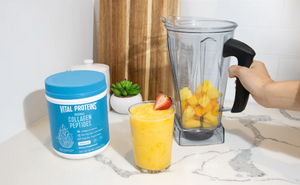If you’ve ever dreamed of flying through the air like you’re in Cirque du Soleil, there is one workout that will take you leaps and bounds closer. Enter, the bungee workout.
It’s the trendy workout craze that has classes popping up all across the country. But you might be wondering if it’s the real deal or just another wellness fad.
In order to give you the 401 on bungee fitness 101, we spoke to four top fitness professionals. Everything you need to know is just a hop, skip and a jump away.

What is a bungee workout?
“Bungee fitness is a choreographed aerial aerobic fitness system combination of resistance training and cardio through the use of overhead elastic suspension harnesses,” says Tyler Read, CEO of PRPioneer.
“You wear a harness around your hips as if you’re strapping in to go rock climbing or on a zip line and then connect that harness to a bungee line, which is attached to the ceiling of your fitness studio,” adds Nerissa Zhang, CEO of The Bright App.
While it originated in Thailand in 2015, the craze has since moved to the States. You can purchase the equipment to do the workouts at home, but it’s much safer (not to mention less noisy for your neighbors!) to attend classes with a licensed instructor.
Is bungee fitness a good workout?
The fitness pros all agree: bungee fitness is a good workout.
It’s a great way to put some spring in your step (quite literally) as elastic resistance challenges different aspects of your fitness all at once. This includes stability, strength and cardio endurance, in addition to stretching that smile on your face.
The elastic resistance strengths and tones the muscles, without causing them to bulk up, says Andrea Fornarola, Founder and Director of Elements Fitness Studio. This is perfect for those looking to develop long and lean muscles — like actual performers you see at the circus.
It’s a total body workout that combines strength training and cardio. And yet, it’s surprisingly low impact. This makes it the perfect exercise for those recovering from various types of injuries, says Fornarola. You can also rely on the aerial motions to increase mobility, adds Jacklyn Fulop, a Board Licensed Physical Therapist and Founder of Exchange Physical Therapy Group.
“The bungee cord takes pressure off the joints which can improve range of motion and build muscle tone and overall strength.”
But the biggest perk of all is how much fun you’ll have. “Bungee workouts are really great because they can be a ton of fun. This can be an excellent motivation to attract people to fitness and keep them committed to showing up to classes,” says Zhang.
Can anyone do a bungee workout?
There are a few considerations to keep in mind before giving bungee fitness a try.
Fornarola advises that anyone with neck, shoulder or spine injuries should sit the workout out. “It's best to contact your doctor before taking a bungee workout if you have these types of injuries because you do not want the exercises to have a negative impact on your body or prolong the healing process of your injuries.”
You shouldn’t attempt it if you’re pregnant and in your second trimester. As always, though, you can contact your doctor to seek out tailored advice.

How do you prepare for your first class?
While a typical bungee workout class starts with a warmup, it doesn’t hurt to do some stretching on your own — especially if you’re lacking in the flexibility department. The key here is to start with dynamic stretches, not static.
This would be a good time to sip on our Vital Performance™ PRE to fuel your workout!
“Dynamic stretching is stretching through movement and can improve your ability to react,” explains Fulop, who adds that static stretches are when you hold the same position for a period of time. If you get them confused, remember this: Dynamic stretching happens before your workout, while static stretching takes place after.
While the goal of the workout is to get fit while having fun, it’s still important to listen to what your trainers are telling you, especially when changing exercises.
Zhang says to wear comfortable clothing, especially on your bottom half since you’ll be resting your weight into a harness. “Synthetic or scratchy fabrics or even short shorts aren’t going to feel great once you’re strapped into a harness and start working up a sweat.”
While you’re at it, don’t eat too soon before training. You want to go flying through the air — not your lunch. “But make sure you’ve had food (mainly carbs) and enough water a couple of hours before training,” advises Read.
Most of all, though, listen to your body! “If something doesn't feel right, ask questions throughout the workout. You want to make sure you are doing the moves and exercises correctly, so you can reap the benefits of the workout and not put your body and muscles through unnecessary strain in case you aren't doing something correctly,” says Fornarola.
How can you use resistance bands at home?
Can’t make it to a bungee fitness workout? No sweat. There is one major component you can do at home and it doesn’t require a leotard.
Resistance band training is a small, cost-effective and portable way to exercise. They also make any exercise more challenging, depending on the thickness of the band, explains Fulop. “Resistance levels are usually color-coded,” adds Read.
When it comes to using resistance bands at home, the sky’s the limit. “You can use resistance bands in all types of at-home workouts!” says Fornarola. This makes them an ideal substitute for heavy workout equipment, such as dumbbells, kettlebells and barbells.
“Some exercises you can incorporate resistance bands into to change things up and add greater muscle stimulus to include ankle jumping jacks with resistance bands, resistance band bicep curls, banded walks, and much more.”
They’re not a one-trick pony, either. You can use them for fitness and stretching, says Zhang. “I especially love how resistance bands help me focus on stretching smaller muscle groups that often get ignored during typical stretching and workouts.”
But before you strap yourself in, Read recommends knowing stable anchor points for your bands, like the right places to place them. “Injury and property damage are far too common when a weak anchor is at play.” You’ll also want to make sure the band is in good condition to prevent it from snapping suddenly.













